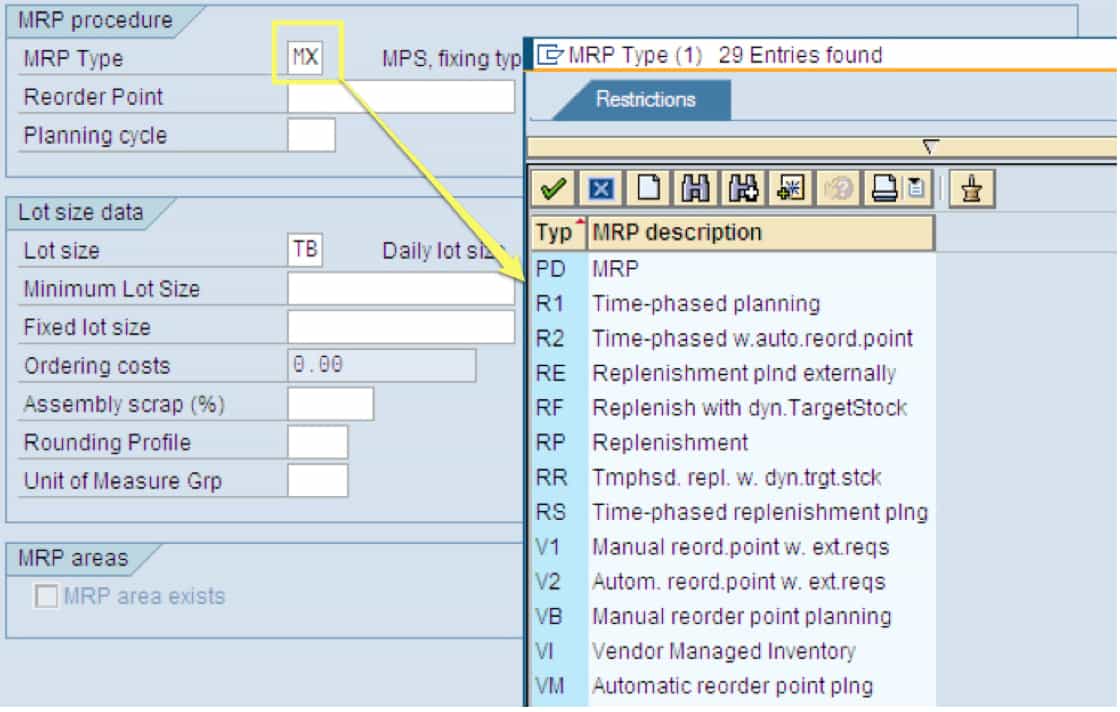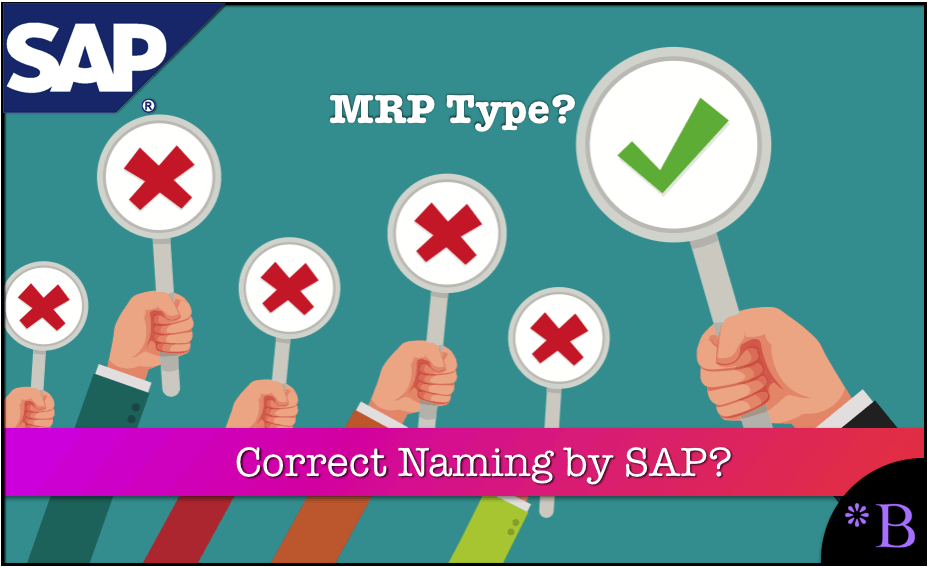Was the SAP MRP Type Field Named Correctly?
Executive Summary
- There are general misconceptions regarding the MRP Type.
- The MRP Type controls many important items in APO.
Introduction
The MRP.Type is a field on the Material Master in ERP which does two things:
- It controls the planning method (whether it’s MRP, MPS, Reorder Point Planning, etc..)
- It also serves as a “switch” that can prepare the ERP system to take a subordinate role (and can do so for any grouping of product location combinations), allowing an external planning system like APO or any other third-party system perform its planning procedures.
Our References for This Article
If you want to see our references for this article and other related Brightwork articles, see this link.
Notice of Lack of Financial Bias: We have no financial ties to SAP or any other entity mentioned in this article.
Misconceptions about the MRP Type Field
One of the general misconceptions about the MRP Type is that they only perform the first activity when, in fact, the second activity is also important. A major problem with the MRP Type field is that it is not actually what it says it is and was misnamed from the beginning. Why I have never heard someone bring this up is strange because it is obviously the case. A simple example can prove this point.
For instance, Time-phased planning and Manual reorder point planning, two of the MRP Types listed below, are not “types of MRP”; they are planning methods. Reorder point planning is designed for specific situations where demand is very simple or tough to forecast. I describe reorder point planning in detail in this article. I also give this extensive coverage in my book on supply planning software.
MRP Type Listing
Therefore calling the field MRP Type makes little sense. The only MRP type that is actual types of MRP are those colored in blue below:
Eleven of the types are dedicated to both MRP and MPS. The four MPS are listed below in orange, and the 7 MRP are listed in blue.
- M0 MPS, fixing type -0-
- M1 MPS, fixing type -1-
- M2 MPS, fixing type -2-
- M3 MPS, fixing type -3-
- M4 MPS, fixing type -4-
- ND No planning
- P1 MRP, fixing type -1-
- P2 MRP, fixing type -2-
- P3 MRP, fixing type -3-
- P4 MRP, fixing type -4-
- PD MRP
- R1 Time-phased planning
- R2 Time-phased w.auto.reord.point
- RE Replenishment plnd externally
- RF Replenish with dyn.TargetStock
- RP Replenishment
- RR Tmphsd. repl. w. dyn.trgt.stck
- RS Time-phased replenishment plng
- V1 Manual reord.point w. ext.reqs
- V2 Autom. reord.point w. ext.reqs
- VB Manual reorder point planning
- VI Vendor Managed Inventory
- VM Automatic reorder point plng
- VS Seasonal MRP
- VV Forecast-based planning
- X0 W/O MRP, with BOM Explosion
The one above, which is in red, says “MRP,” but of course, it is without MRP. X0 does not perform MRP but does perform BOM Explosion. XO is the most common.

These are the differences between the different MPS runs; these are the same between the four listed MRP runs.
Why So Many MRP and MPS Selections?
There are so many MRP and MPS selections because they are slight variations of each other that primarily have to do with firming and when procurement proposals are created.
“0 – Procurement proposals are not firmed
1-Procurement proposals within the planning time fence are firmed automatically as soon as their date is at least one day before the end date of the planning time fence. The date of new procurement proposals created in the planning time fence is moved to the end date of the planning time fence. As a result, these new procurement proposals are not firmed.
2 -Procurement proposals within the planning time fence are firmed automatically as soon as their date is at least one day before the end date of the planning time fence. No new procurement proposals are created automatically within the planning time fence; that is, the shortage situation is not adjusted within the planning time fence.
3 – Procurement proposals within the planning time fence are not firmed automatically. All procurement proposals required to cover the requirements are moved to the end of the planning time fence.
4 -No procurement proposals are created automatically within the planning time fence; that is, the shortage situation is not adjusted within the planning time fence.”– SAP Help
SAP’s Incomplete Explanation
Interestingly, the SAP documentation and explanation on this topic is incomplete.
Some MRP types allow procurement proposals to be created in the past, which is not covered in the documentation.
The MRP Type Explanation Matrix
The graphic below shows the official SAP documentation converted to a matrix for better understanding.

The first five columns are from SAP documentation, and the sixth column is from observation of how the system operates. Obviously, the SAP documentation does not explain all the differences between the firming types because if it did, some of the firming types would be duplicates.
MPS MRP Type?
MRP is one way of (sort of) implementing MPS; however, MPS is not a form or type of MRP. In fact, because MRP cannot be constrained, there is a question of whether MRP can be a simple MPS. MRP can always be capacity leveled, but one of MPS requirements is that it is constrained. Constraining is one factor, but four factors make up an MPS listed in this link.
Therefore, it is also inaccurate to list MPS as an MRP type, and in fact, the field’s name is inaccurate in some different dimensions.
The APO Relevant Field
The APO Relevant Field controls if a product location combination will be “planned” in APO. However, it is important to add more specifics to the term planned. This is because we speak of a product being planned in one system or another. For instance, the most common distinction is between critical products planned entirely in APO versus non-critical products being planned entirely (usually with MRP) in the ERP system. Under this design, the delineation between being “planned” in one system or another is very clear. However, this distinction becomes less clear when one of the planning stages is performed in one system and a second in another. This is because “planned in” is not a sufficiently detailed description to explain what is happening and where it is happening.
A product can have the good finished planning performed in APO, but then the sub-components planned, either with MRP or with simple BOM explosion. For products with multiple nesting in their bill of material, the finished good could be planned in APO, with the semi-finished good and raw material planned in R/3, or both the finished good and semi-finished good could be planned in APO, and only the raw material planned in R/3.
Field Specifics
For a product to be planned in APO, the master data such as the product and location must be set up in APO, but also the transaction information must flow between APO and R/3. The APO Relevant Fieldsets this up properly for product locations that are not entirely planned in R/3. Again, a product location combination can be partially planned in APO and partly planned in R/3. However, if any planning is to occur on a product location in APO, the APO Relevant Field on the Material Master in R/3 should be checked.) Without this field is checked, data will not flow between APO and R/3 as R/3 will assume all planning is being performed internally to R/3.
Conclusion
The MRP Type is not what it says it is and has been misnamed. A better name would have been the “planning method.”
The common misnaming of SAP fields by people I can only suppose that English was a second language continues to cause large problems on SAP projects. I can think of no other supply chain vendor that continually misnames its fields in this way, so it is important to describe the misnaming for people on the project. The overall functionality of MRP and MPS could be explained better by SAP.
